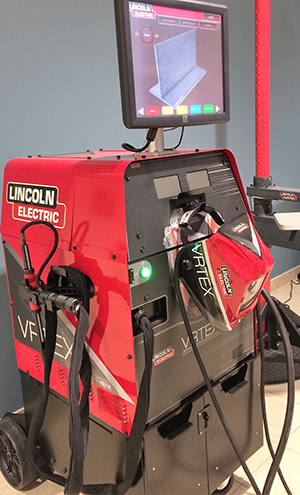Whether you are in high school attempting to settle on a career, an adult back to school to upgrade skills or a young child dreaming of what to be when you grow up, equipment coming soon to Kent Career Tech Center should be on your must-investigate list.
A $300,000 Career and Technical Education (CTE) Innovation and Equipment Grant from the Michigan Department of Education will be used to purchase virtual welding equipment.
In the virtual world, anything is possible, so once in the headset, you can experience firsthand working in a power plant, building a bridge, or putting finishing touches on your personal race car.
The MDE grant was one of 14 awards totaling $5 million to local and intermediate school districts, to be used to purchase specialized equipment and expand programming in manufacturing fields. Kent ISD officials are still in the ordering process of an unspecified number of machines, but expect them to be ready for the Tech Center’s summer session.
“As a recipient of these grant funds, Kent ISD will be able to provide safe and cutting-edge welding technology to our current students in a variety of programs,” said Campus Principal John Kraus. “These tools will allow students to practice to proficiency before actually cutting and attaching actual metal. This is safer, greener, and consumes considerable less material.”
In addition, virtual welders will enhance Tech Center skilled trades programs designed to ready students for a job market hungry for their skills.
“Welders, cutters, solderers, and brazers are listed on the most recent ‘Hot Jobs’ report for Region 4 due to projected job growth from West Michigan Works! 2017,” said James Hissong, Kent ISD development and grants coordinator. “This expansion of our welding capacity is a direct reflection of local workforce demands and feedback from employers.”
John Doneth, a welding instructor at Grand Rapids Community College, agrees.
“We have had a shortage in all skills trades for the last number of years,” he said. “For 20 years or more education has been focused on getting kids to college, but this type of work requires high tech and high skill.”
Doneth added that “there is a whole group of people who would excel at these types of things” and it is the job of schools to find and train them. Getting students interested in skilled trades early is one key.
When GRCC transports a virtual welder to surrounding schools and events such as Career Quest, there is always a line to see it. “It helps us engage students and begin to change their perception about the skilled trades,” Doneth said.
Kent ISD officials say adding the machines to the Tech Center campus will help increase interest in the skilled trades.
“We will develop new outreach opportunities that can include middle school students, high school students who do not attend KCTC, post-high school training for apprenticeships, and adult or corporate training,” Kraus said.
While it is too early to know how many of the students lining up to try the virtual reality machines will choose careers in skilled trades, Doneth is convinced GRCC’s efforts are necessary.
“It is important for kids to see what’s out there for them. If they are interested they will dig deeper. I am not sure how many will go this direction, but I do know many of them think it is pretty cool.”

Virtually ready
While the Tech Center currently does not have a stand-alone CTE program for welding, it does offer welding as a component in other programs, according to Kraus. All six subject areas — Diesel, Auto, Auto Collision, Precision Machining, Mechatronics and HVAC – will utilize and benefit from the new high-tech welders, he said.
Over the past five years, Kent ISD has made significant investments in welding equipment at the Tech Center, including adding welders, welding booths, tables, and an oxy/acetylene cutting area, as well as doing necessary upgrades to accommodate the work.
The addition of virtual equipment has multiple benefits.
The computer-based training systems are educational tools designed to supplement traditional welding training. They are environmentally friendly, allowing students to practice techniques without using physical materials. This saves on costs to purchase materials and not waste metals that could be used elsewhere, plus eliminates the need for extensive safety training before actual welding begins, said Doneth.
Additional Benefits of Virtual Training
After putting on the headset, the student chooses a virtual setting, such as which job will be performed and location in which it will be performed. The next step is to figure out and set the variables, such as size, width and weight of metals being used. Then with the wand of the virtual welder, the student steadies his or her hands to weld the computer-generated pieces of metal together.
In addition to conservation and safety, there is the educational benefit of accurate and immediate feedback. The computer outlines a number of variables of the actual weld, including straightness, speed, accuracy, and final product.
“A welding student really can’t get that much information even if the instructor is standing right over him while he works. This technology has really expanded our effectiveness,” said Doneth. “The student can see the issue and even start over and redo the entire project. Before the only feedback sometimes was the actual weld.”
The purchase of virtual welders may also enable the Tech Center to offer certification. While standards differ from company to company, having basic welding skills is “one more certification we can offer to our students,” Hissong said.
Collaborating with GRCC to obtain the grant has strengthened the Tech Center’s relationship with the college. According to Doneth, the college was previously unaware of how much welding experience former Tech Center students had. Working together not only makes it easier for students to negotiate the pathway from high school to college, but also into the workplace.
Through the partnership, Kraus added, “we will see new opportunities for Tech Center students to earn college credit in welding technologies before finishing high school.”
CONNECT













